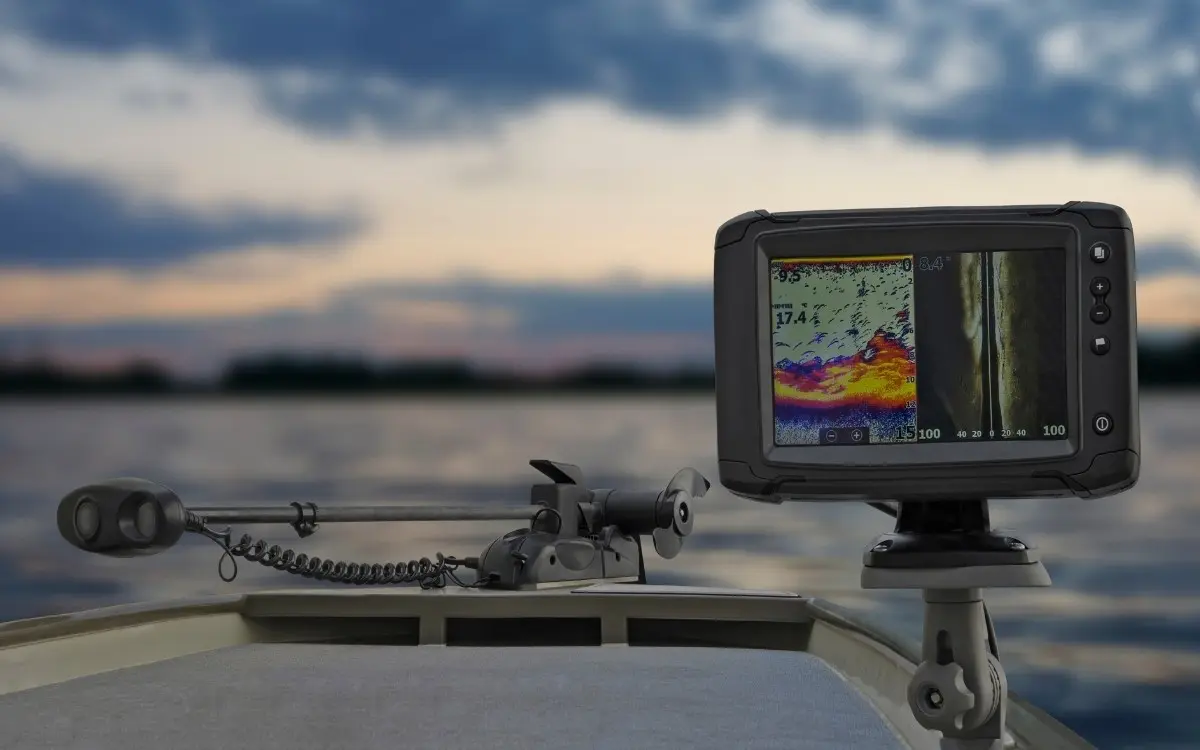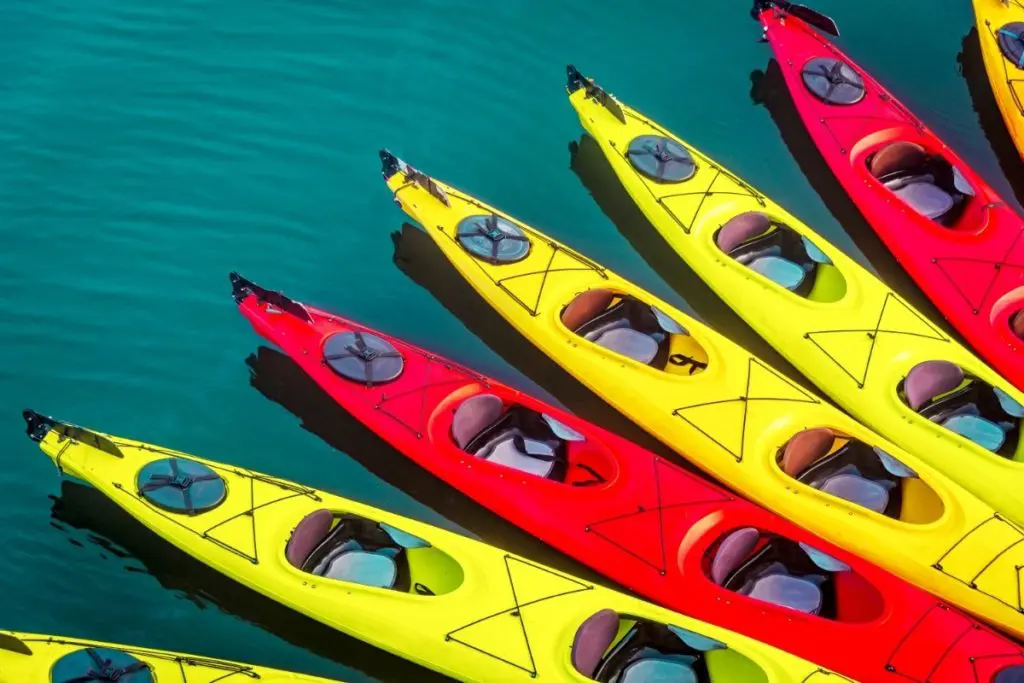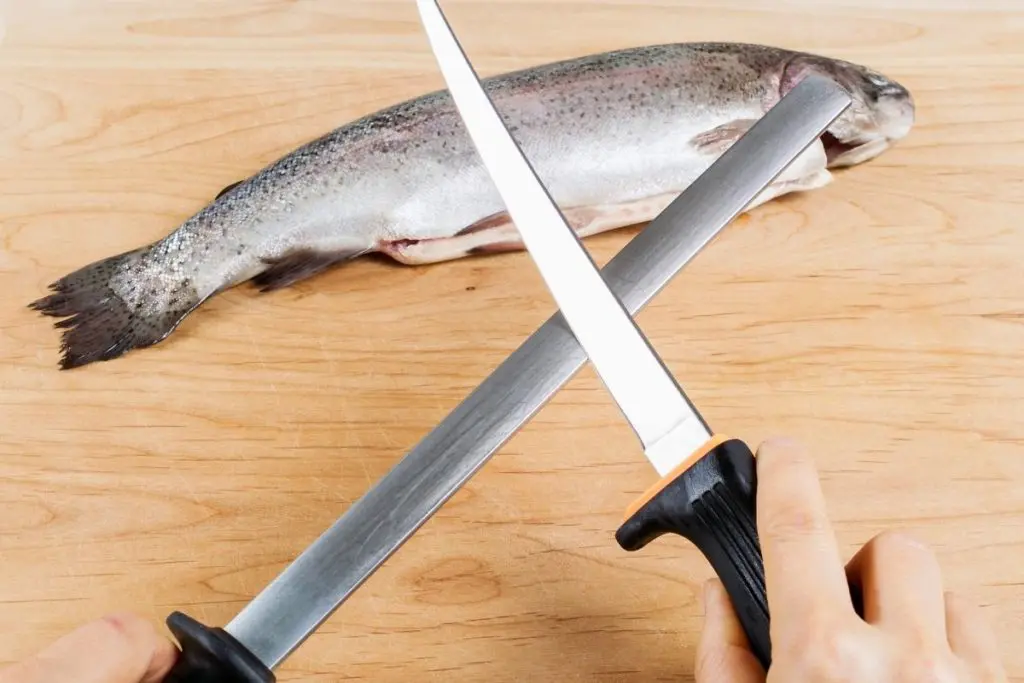Fish finders (also known as sounders) do exactly what you’d expect: they help you find fish. Using state-of-the-art sonar, fish finders identify schools of fish and determine the water’s depth to show you precisely where to cast your line. In a nutshell, the best fish finders make for a more effective, less frustrating angling experience, and ensure you bring home plenty of fish.
Unfortunately, searching for a trusty fish finder can be just as hard as fishing without the handy little device. That’s why we’ve taken the time to research for you, and come up with this list of the five best fish finders.
Our Top Picks: Best Fish Finders
If you’re in a hurry, here’s the bottom line:
- Best Overall: Humminbird HELIX 5. With a built-in proprietary Basemap, GPS capability, CHIRP radar, and AutoChart Live real-time maps, this fish finder takes the hassle out of your day on the water.
- Best Budget: Garmin Striker 4. With the Garmin Striker 4, you can get the quality you want at the price you can afford. But don’t take our word for it — read a few of the thousands of five-star reviews!
- Best Portable: Deeper Pro+. Fish finding is now possible from the shore, the dock, the bridge, and the ice thanks to this castable device that connects wirelessly to your smartphone or tablet.
- Best for Kayaking: Raymarine Dragonfly 7Pro. Thanks to a ball-and-socket mounting system with dual-channel CHIRP, there’s no better fish finder for the avid kayaker.
- Best Luxury: Lowrance Elite-5 Ti. If you’ve got cash to burn and want a fish finder that does everything for you (except reeling in the big ones), look no further than the Lowrance Elite Ti series!
1. Humminbird HELIX 5 CHIRP SI GPS G2 Fish Finder
The best fish finder overall
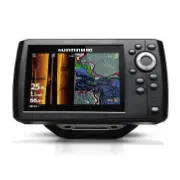
Manufacturer: Humminbird | Sonar: Sidescan & Downscan | Frequency: 50/83/200/455 kHz | Max Depth: 1,500ft | Price: 💰💰💰
The Humminbird HELIX 5 offers an incredible widescreen display in full color. The HD 800H X 480V LED-backlit screen ensures crystal-clear readings for precise fishing. With 2D sonar that’s anything but two-dimensional, you’ll be able to see individual fish rather than vague blobs.
Choose from two different display modes to suit your preferences. The wide beam setting searches broader areas to get you closer to the fish, while the narrow beam setting gives you the precision you need to make the catch. The digital CHIRP radar covers multiple frequencies simultaneously, meaning those fish can run, but they can’t hide!
Humminbird’s proprietary Basemap is built into this GPS-equipped device, supplying you with up-to-date freshwater terrain data from LakeMaster and NOAA. The AutoChart Live feature creates real-time maps of your favorite fishing spots, so every return trip is more successful than the last.
Reviewers Like
- Precise detail takes the guesswork out of fish finding
- Sophisticated device with user-friendly interface is easy for anyone to operate
- Compact transducer design is perfect for smaller vessels and detachable mounts
Reviewers Dislike
- Motorized movement blurs imaging
- Getting the transducer at the best angle takes some trial-and-error
2. Garmin Striker 4 3.5” GPS Fish Finder with Chirp Traditional Transducer
The best fish finder for the money
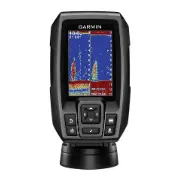
Manufacturer: Garmin | Sonar: Downscan | Frequency: 50/77/200 kHz | Max Depth: 1,600ft (freshwater) / 750ft (saltwater) | Price: 💰
Fish finders are notoriously expensive (though definitely worth the investment), but that doesn’t mean you can’t get one if you’re on a budget. The Garmin Striker 4 is one of the most inexpensive fish finders on the market, with thousands of five-star reviews to reassure you that you aren’t sacrificing quality in the name of a good deal!
Though the 3.5-inch screen is a little small, it offers a resolution of 480 x 320 pixels, and comes with the modern CHIRP technology that allows you to pinpoint individual fish with startling accuracy. Not only that, but the high-sensitivity GPS ensures accurate directions on your way to and from the water. Sonar history lets you relocate waypoints you may have missed, and the built-in flashers and speed data display give you plenty of guidance as you go.
Reviewers Like
- Simple keypad operation is easy to use
- Multiple upgrades enhance performance for any budget
- Excellent sonar with high-quality transducer at an affordable price
Reviewers Dislike
- The GPS is basic and not as accurate as higher-end options
- CHIRP offers high accuracy, but the small screen and mid-range resolution can obscure those results
3. Deeper Pro+ Smart Sonar GPS Wireless Wi-Fi Fish Finder
The best portable fish finder
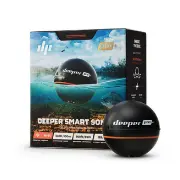
Manufacturer: Deeper | Sonar: Downscan | Frequency: 90/290 kHz | Max Depth: 260ft | Price: 💰💰
The Deeper Pro+ is a portable, wireless fish finder specifically designed for use in “unreachable” locations, whether you’re on a bridge, a dock, the shore, endless ice, or even just a boat or kayak without a mount.
Bluetooth technology sends sonar readings to your tablet or smartphone from depths up to 130 feet below the surface, in both fresh and salt waters. The device itself fits in the palm of your hand, and as readings are sent to your phone, you don’t need a separate display, saving you valuable storage space on your trip. And, the dual-frequency sonar beams at 290 kHz and 90 kHz ensure accurate results.
The associated app has additional features like sonar data logging, so you can store up to 15 minutes of results for revisiting. It also features online maps and GPS, and even a fish activity calendar so you know what friends you can expect to encounter on your trip. Deeper Smart Imaging gives you a detailed look at the topography under the water for more accurate searching, while the temperature sensors give you precise updates on temperature fluctuations that might impact fish activity.
Powered by a rechargeable battery, the device can last up to four hours on a single charge.
Reviewers Like
- Takes mere minutes to set up and use
- Free online account lets you upload scans for future reference
- Enables fish finding in odd locations, as you can cast the device from your fishing line and read the results on your phone
Reviewers Dislike
- Some reviewers had issues with occasional false readings
- The device has to be cast out, reeled in, and exchanged for a lure every time you want a reading (unless you bring more than one pole)
4. Raymarine Dragonfly 7Pro Fishfinder
The best fish finder for kayaking
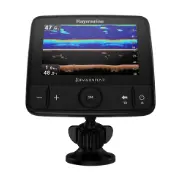
Manufacturer: Raymarine | Sonar: Downscan | Frequency: 320-380 kHz | Max Depth: 600ft | Price: 💰💰💰
With the biggest and brightest display of the Dragonfly line of fish finders, the 7Pro offers unmatched sonar imaging with wide-spectrum CHIRP DownVision to bring you precise, near-photograph quality results. The optical bonding LCD, only available on higher-end devices, gives you brighter colors, sharper contrasts, and clearer images so you can pinpoint fish location with ease.
With the addition of high-speed bottom tracking, you’ll see comprehensive views of the underwater terrain. The ball-and-socket mounting system offers a range of viewing angles to suit personal preference and any environmental glare. Built-in Wi-Fi capability allows you to connect to your smartphone or tablet via the Raymarine Wi-Fish mobile app. You can display, record, rewind, and share sonar images, ensuring you get the most out of each reading. Whether you’ve got a detachable mount or a built-in port on your ‘yak, this fish finder will ensure you can find fish as you float atop the water.
Reviewers Like
- Integrated GPS navigation
- Dual-channel CHIRP sonar for more precise targeting
- The user-friendly interface is easy to operate out of the box
Reviewers Dislike
- On the pricier side
- Does not come with Navionics Charts
5. Lowrance Elite-5 Ti with TotalScan Transducer
The best fish finder when money is no object
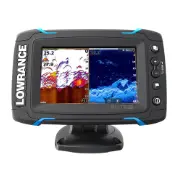
Manufacturer: Lowrance | Sonar: Downscan & Sidescan| Frequency: 83/200 /455/800 kHz| Max Depth: 1,000ft | Price: 💰💰💰💰💰
The Elite-5 Ti features the same touchscreen operation you’re used to on your smartphone, making the interface easily navigable. Thanks to its wireless connectivity, you can also link your Elite-5 Ti with your smartphone and view your results from anywhere. You can even raise and lower your Power-Pole shallow water anchor with the touch of a button, download software updates or C-MAP Genesis maps, and upload detailed service reports to customer support from the comfort of your own device. With the preloaded C-MAP, you can narrow your search by criteria such as ledges or drop-offs, and can get bird’s eye views of more than 11,000 lakes.
FishReveal Smart Target View combines CHIRP sonar with higher-resolution DownScan imaging so you can see everything you need, including bottom detail, structure, and bait fish. This combination eliminates the need for a split-screen display and is more intuitive to read than glancing back and forth between two different results. The TotalScan transducer offers Med/High CHIRP, StructureScan HD SideScan, and DownScan imaging, meaning you won’t have to drill multiple holes in your boat to mount different transducers for each. Enjoy the fish-targeting views of sonar with the photographic images of structure and cover beneath your vessel.
Our favorite part about the Elite-5 Ti? The Trackback feature lets you review sonar history in case you miss your chance to mark a structure or want to double-check a previous result. Pretty cool.
Reviewers Like
- TotalScan transducer is the all-in-one solution you didn’t know you needed
- Ultra-fast processor with responsive touchscreen interface makes it quick and easy to use
- Sophisticated features lead you directly to the fish so you can spend your time fishing, not searching
Reviewers Dislike
- All the features can be confusing for newcomers
- For all the amazing features, the price is proportionally extravagant
What to Look for in the Best Fish Finders
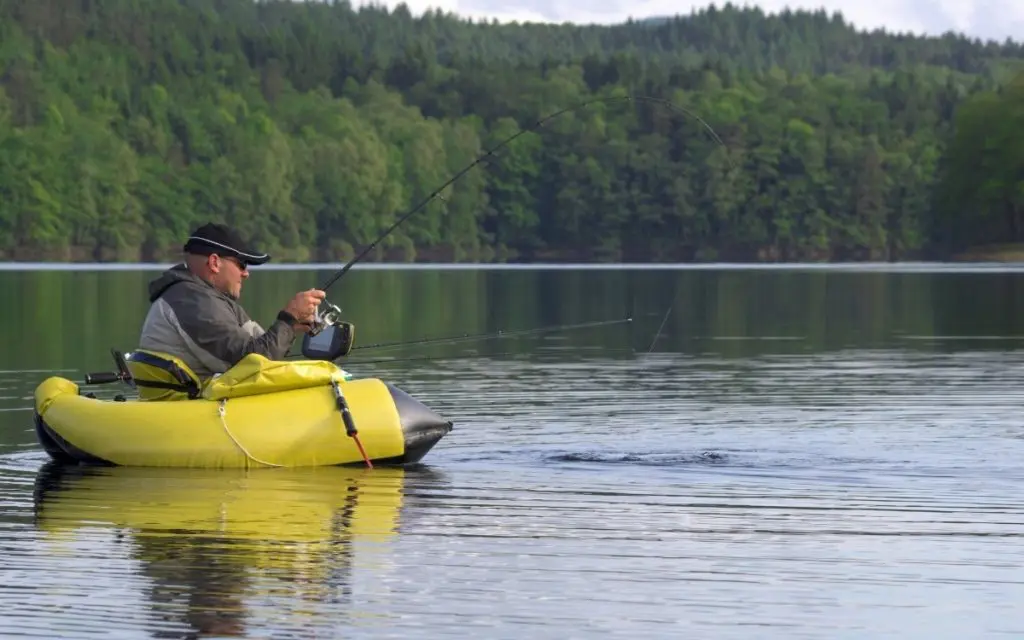
To help you narrow down your search for the ideal fish finder, here are a few factors to keep in mind:
1. Downscan Sonar
Downscan sonar increases the accuracy of your readings once you reach forty feet deep. It also allows you to see greater detail, such as individual fish in a school. That said, downscan sonar can be too powerful for shallow water, and it may be challenging to see activity happening to the sides of the boat.
2. Sidescan Sonar
Sidescan sonar scans vast amounts of water in a single pass, averaging around 100 feet to each side. You can quickly scan areas without disturbing them, as you don’t need to go directly over the area to scan it.
That said, sidescanners are less effective in deep water situations. On average, when you go down 75 feet or more, things start to get blurry, and you’ll notice a decline in imaging quality.
3. Network System
Network systems support a wide range of data sources, such as radar, Sirius Satellite Radio, and raster and vector GPS charts. Multi-display networked systems are excellent options for medium to large-sized vessels. Networked systems generally use Wi-Fi and/or Bluetooth capability. Some can even connect to an app on your smartphone!
4. Frequency
Fishfinders function by using a single frequency, dual frequencies, multiple frequencies, or a broadband CHIRP system. A good rule of thumb is that the higher the frequencies, the better the details and resolution.
Higher frequencies also will give you the best view from a fast-moving boat, but they won’t penetrate as deeply as lower frequencies. For maximum penetration, use lower frequencies such as 200kHz or higher (up to 800kHz) for water depths of 200 feet. If you’re going deeper than that, 80kHz or 50kHz will be your best bet. Shallow waters call for higher frequencies of 200kHz up to 800kHz.
5. Power
Max Wattage in RMS measures how much power the finder unit can consistently output. Peak to Peak is the measurement of total output. For deepwater applications, look for at least 250W of RMS power and 2500W (Peak to Peak). Keep in mind that the more power output your transducer has, the more detailed, accurate, and clear the image is on your solar screen.
6. Screen
Another critical factor is display specifications, which includes screen size, resolution, color, and overall quality. A widescreen with a high pixel count will guarantee a clear sonar image and is ideal for split and multiple views.
Our Process
For this guide on fish finders, our team spent 3 hours researching the most popular options from over 10 brands and manufacturers big and small. We then read about eighty user reviews (both positive and negative) to discover what shoppers thought about each finder. After comparing this data, we narrowed our list down to the top 5 fish finders on the market. You can count on this research to guide you to a mindful purchasing decision.
If you enjoyed this read, sign up for our newsletter below and get special online shopping deals delivered straight to your inbox.
Further Reading
